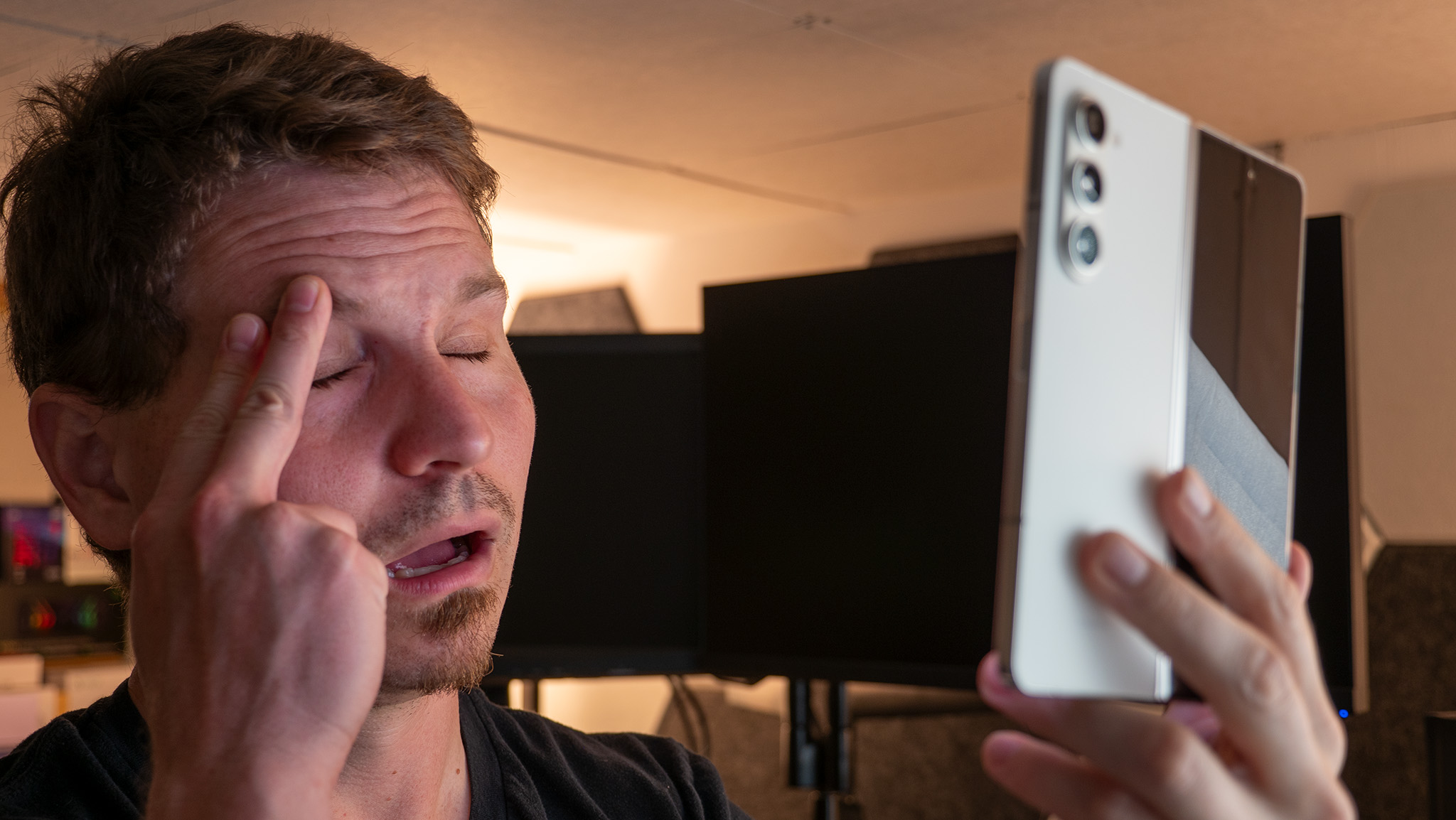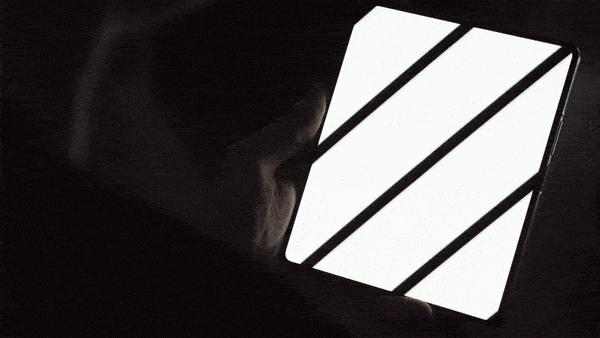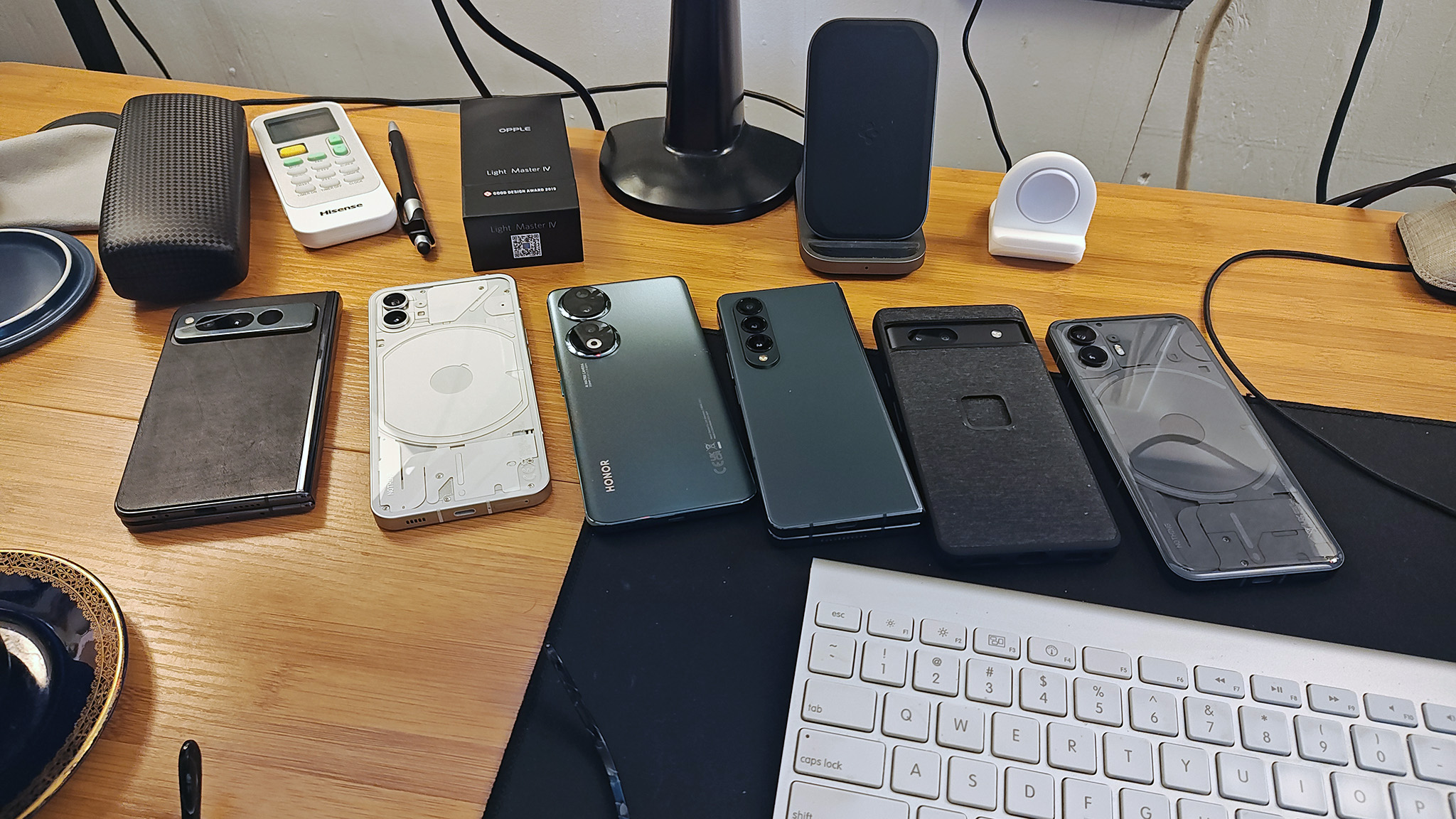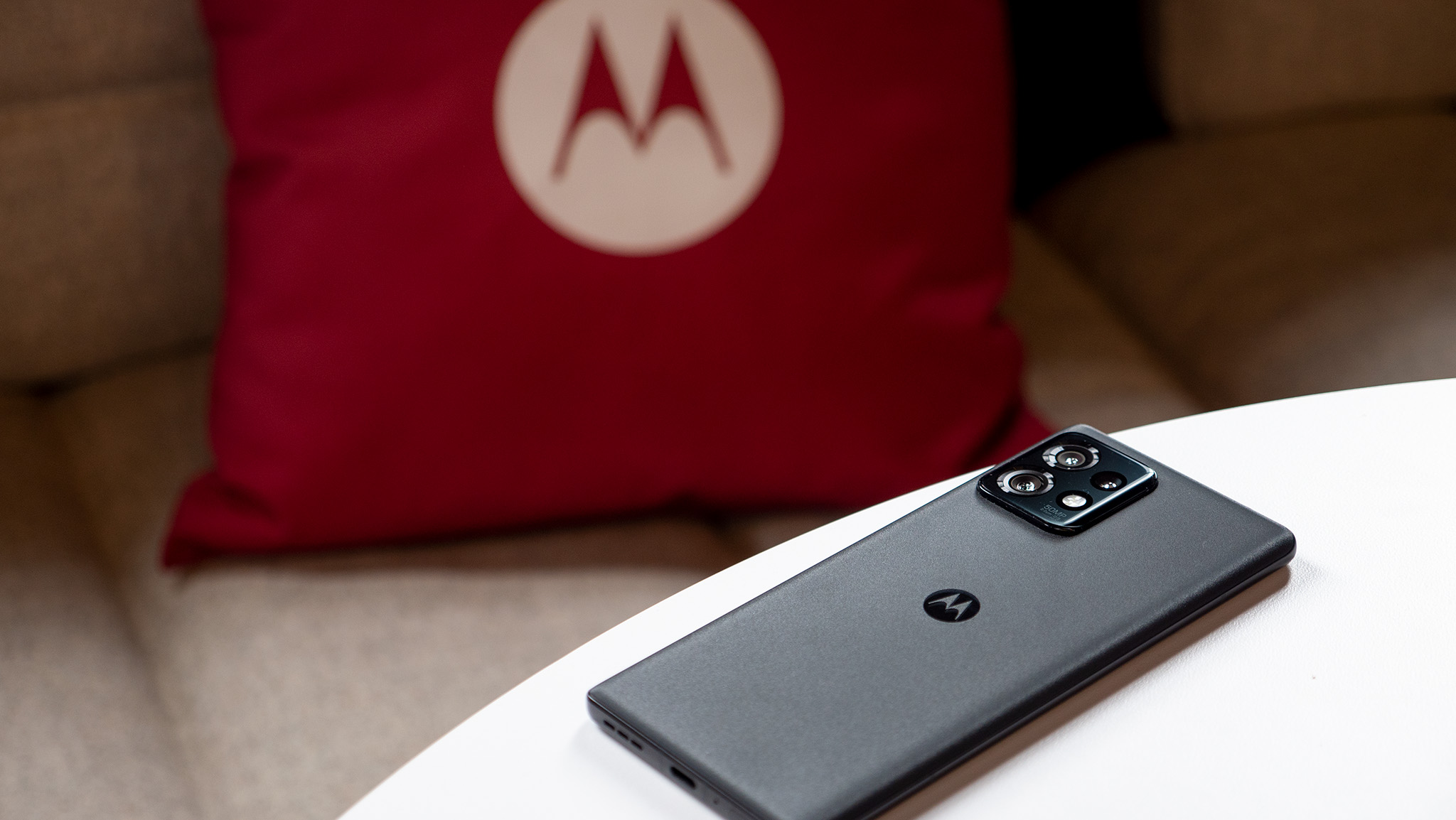The Galaxy Z Fold 5's display makes me want to curl up into a ball and die
Samsung's flickering displays are making me hate its phones.

In 1997, a publicly televised episode of the Pokemon show sent hundreds of Japanese children to the hospital. No, it wasn't in shock over Pikachu winning yet another battle. It was due to a series of flashing lights that appeared in the episode. Ever since then, filmmakers have learned to avoid such scenes, and most video games we play begin with a warning about the possibility of epileptic seizures during some scenes.
So why is it that display and phone manufacturers thought it would be a good idea for the best phones to do exactly this on a daily basis? The phenomenon is called pulse width modulation — or PWM — and it's something I wrote about three months ago when I learned that, after 12 years of reviewing phones, I've become sensitive to flickering displays and lights. In a nutshell, that flickering makes me dizzy, confused, and nauseous if I don't stop using the phone.
Since then, I've interviewed several companies and experts on the matter, done hours of research, visited the optometrist and got a new glasses prescription, and put myself through all sorts of uncomfortable hell to figure out why companies like Samsung think it's a good idea to flash bright lights at human eyeballs. I initially reached out to Samsung in May but didn't hear back. Follow-up attempts were made in June and later again in July when I attended the hands-on event at Samsung Unpacked.
And I'm not the only one with this issue. Every day, more people join the ranks of PWM sensitive, as evidenced by the growing numbers of users on related forums. Unfortunately for me, and anyone out there like me, phones like the Galaxy Z Fold 5 are basically unusable unless you find the right combination of adjustments that work for you.
Why write this now?
Much of my frustration isn't even because of my own pain or the pain of others. It's because the biggest tech companies don't seem to want to listen to the growing number of users that are unable to use the latest phones. It's because these same companies don't want to talk about the problem at all, as if ignoring it will magically make it go away.
Over the past few months, I've reached out to companies like Samsung, Google, Nothing, Motorola, Honor, Asus, and others not just to learn more about why displays work they way they do but, more importantly, why these companies make displays work the way they do.
I've been given the cold shoulder more than once by these companies, and it makes me feel like they're hiding something.
Would you believe that most of them don't even seem to know? Either that, or they are purposefully feigning ignorance on a topic because they haven't done enough research to back up their reasons and don't want to get in trouble.
Get the latest news from Android Central, your trusted companion in the world of Android
I've been given the cold shoulder several times and, in most cases, was either told (in not so many words) that display flicker wasn't a consideration in the design process or that it's not something they can talk to me about. Why? Are they hiding something? I'd certainly love to know, and I think a lot of other people would, too.
Flash in the pan

If you've ever been looking at your phone late at night and wondered why your eyeballs ache, it's probably not because you're tired. As most modern phone screens dim, they flash more and more often, resulting in your eyeballs perceiving the display as getting dimmer.
The reality is that your display likely isn't "dimming" at all — not the way you would expect an old incandescent lightbulb to. Instead, your phone is flickering between the brightest the LED diodes can get and the darkest they can get, usually at a rate of hundreds of times per second.
Those lines you see above are the camera's way of capturing the effect. Here's the effect in action. In essence, this is what my brain perceives despite my eyes not being able to "see" it.

In the case of the Galaxy Z Fold 5's display, this occurs at 240 times per second. The IEEE — that's the international standards organization — in all their wisdom, decided that flicker in light sources is acceptable so long as the light source flickers more than 100 times per second.
Anything above this rate is known as "invisible flicker," a term that derives from decades-old research that showed humans can't see light flicker above 100 times per second on average. The problem is that this research only focused on the eyeballs themselves, not the brain that has to process the images fed to the eyeballs.
What your eyeballs see and what your brain perceives are two very different metrics. Unfortunately, most companies seem to only be concerned with the former.
What your eyeballs see and what your brain perceives are two very different metrics, and, unfortunately for us as humans living in a world of flickering LEDs, little to no research has been conclusive about what level of flicker is actually damaging to human brains.
The problem is further compounded by display tricks in modern displays that go well beyond the scope of the IEEE PAR 1789 standard used to determine "safe" flicker rates for display and phone manufacturers.
Companies like Apple and Nvidia use something called temporal dithering to boost color depth on displays artificially. Temporal dithering occurs when a pixel rapidly flashes between two colors to create a color that doesn't actually exist.
The crux here is that while your eyeballs can't see the flash, your brain actually interprets this flash as an entirely different color. Go back to grade school when you mixed red and blue paint to create purple, and you'll quickly understand how the concept works; the difference here is that the artist's palette is your brain instead of a physical piece of wood.
Companies like Apple and Nvidia play nasty flickering tricks with pixels to fool your brain into seeing colors that don't exist.
It's a dangerous game that manufacturers are playing just to try to get better-looking performance or richer-looking visuals at the expense of our collective health.
Macbook Pro users have been complaining about this problem for years, but their cries seem to fall on deaf ears for companies that seem to only care about pushing certain specs instead of allowing users to adjust settings to fit their lifestyle or comfort levels best.
Imagine not being able to adjust your monitor's resolution or text scaling just because a company thinks that's how things should look. This is no different, and it needs to change. Immediately.
What's making this worse?

While I hate to throw Samsung under the bus — they really do make the best phones in the world — the reality is that Samsung's AMOLED displays have the worst flicker rate in the industry. At 240Hz, it is abysmally low by any metric — Apple doubles this rate on the Samsung panels they use for the iPhone, but 480Hz is still too low — and the rate of flicker that Samsung finds acceptable is anything but.
Over the years, more and more phones have begun to use Samsung AMOLED panels. They're often thought to be the best displays — OnePlus reportedly delayed their new foldable phone to switch to Samsung panels because they're "better" — but this doesn't take a user's health standpoint into account.
Most of the best-selling phones on the market use Samsung AMOLED panels. All iPhone models use it, all Pixel phones use it, and almost anything with the Galaxy branding uses it, in addition to most other flagship phones, as well.
As more and more phones and other displays have begun using AMOLED panels, more and more users are being exposed to slow display flicker without realizing it.
Samsung might make the best phones but it makes the most harmful displays.
In my case, I started feeling the effects of PWM sensitivity last September, about one month after I started using the Galaxy Z Fold 4 as my daily driver. Over the months, as I used it for hours a day — particularly for gaming on that nice, large display — my eyes started feeling worse and worse.
By March, 7 months later, it got to the point where I couldn't use my phone for more than a few seconds at a time before my head started spinning.
Since then, I've been to the optometrist and was diagnosed with an astigmatism in my left eye. According to metrics by groups like optometrists.org, 1 in 3 people have astigmatism, which means their eyeball isn't as spherical as it's supposed to be.
Based on metrics I've gathered from the PWM-sensitive community on Reddit and the LEDStrain Forum, many people with astigmatism also suffer from PWM sensitivity. It's not a 1:1 ratio, but there's absolutely a high correlation between data points.
Motorola offers flicker-free phones yet still uses OLED panels (not made by Samsung).
Sure enough, wearing my reading glasses that correct for astigmatism seems to solve the problem, but it's also not a solution that works for everyone.
But here's the kicker: not all OLED panels cause problems, and not all LCDs (or other display types) are safe, either. LG OLED TVs, like the one in my living room, don't flicker at all and are completely safe to use.
The Fold 5 is actually worse for me because Samsung increased the brightness of the display. How could this cause problems? Remember that these AMOLED panels flicker between very bright and completely off to trick your eyes into thinking the display is darker than it really is. The brighter a display can get, the wider the chasm that exists between the bright and dark flicker states.
The Fold 5 is worse than the Fold 4 because it's brighter, widening the chasm between the brightest and dimmest flicker states and causing more eye strain.
Worse yet, turning the phone to "maximum brightness" doesn't eliminate flicker on Samsung AMOLED panels because Samsung uses a technology it calls Vision Booster. 1,750 nits are simply too bright for a display to stay at 100% of the time, as it'll cause burn-in, make the display hot, and drain a phone's battery very quickly.
Because of that, Samsung AMOLED panels are still in the off-state 20% of the time, even at "maximum" brightness. That means your display is always flickering, even when it's not supposed to. When I asked Samsung what could be done about this, they gave me a half-hearted answer to use the Towsemi app on the Play Store.
Even at "maximum" brightness, Samsung AMOLED panels flicker far more than other companies OLED displays.
This app artificially lowers phone brightness by placing a semi-transparent grey layer on top of whatever app is running on your phone, making it appear dimmer than it actually is.
That would be a good solution if Samsung's displays actually stopped flickering at high brightness levels. The problem is, they don't. Even at "maximum" brightness, Samsung AMOLED panels flicker far more than other companies' OLED displays.
Who is going to fix this?

The answers I've gotten are both frustrating and hopeful. Companies like Google, Samsung, and Apple don't seem to be interested in providing a fix for affected users. I've tried several avenues to begin discussions and have been met with silence or indifference each time.
Thankfully, a number of companies are waking up to the call and providing users with solutions that actually work. For me, the company with the best solutions is Motorola. Phones like the Motorola Edge+ (2023) and the Motorola Razr+ offer real solutions that help solve the flicker problem while still providing users with quality OLED panels.
I interviewed Motorola to find out more about what the company's "flicker reduction" setting actually did and how it aims to offer affected users a bastion of devices to choose from.
Without getting in the weeds, Motorola's anti-flicker setting — which can be enabled in the phone's display settings — ensures that an OLED-powered Motorola phone's duty cycle remains on 99.51% of the time at certain brightness levels. Motorola is utilizing a DC dimming-like solution to achieve this metric, and it was obvious from the moment I used either of the aforementioned 2023 Motorola phones.
Other companies like Nothing are using similar methods but do it automatically at higher brightness levels. This means phones like the Nothing Phone (2) are actually usable for PWM-sensitive folks. Better yet, if they need to dim it below 47%, apps like Towsemi will actually work since the phone uses DC dimming at higher brightness levels.
Nothing's displays also flicker at a rate of 1,920Hz — that's 1,920 times per second, or nearly 10x faster than Samsung's 240Hz rate — which will help some PWM-sensitive folks even at lower brightness levels. Every human is different, though, and this solution doesn't work for me.
Other companies like Honor are using displays certified by TUV Rhineland, a company that specializes in display research and certifications. The Honor 90's marketing, as a result, has focused heavily on eye health and comfort. That's something companies like Google, Apple, and Samsung seem to actively avoid.
A few companies, like Motorola, Nothing, and Honor, are finally seeing the light and making OLED phones that are more eye-friendly.
Honor's solution will also not work for everyone since it still flickers — albeit at an extremely high 3,840Hz — but it's a substantial improvement over Samsung-made AMOLED panels.
And yes, in case you were wondering, Motorola uses OLED displays from LG, while Honor and Nothing use OLED displays from Visionox. Notice none of these companies use Samsung AMOLED panels.
If you're like me and suffer from headaches, eye strain, nausea, or a general feeling of awfulness after using your phone, go see an optometrist first. After that, try some phones that aren't made by Apple, Samsung, or Google and see if the problem subsides.
Until these three see the light and start acknowledging the problem, the only real solution is to stop buying the goods they're peddling.
Phone deals: Best Buy | Walmart | Samsung | Amazon | Verizon | AT&T

